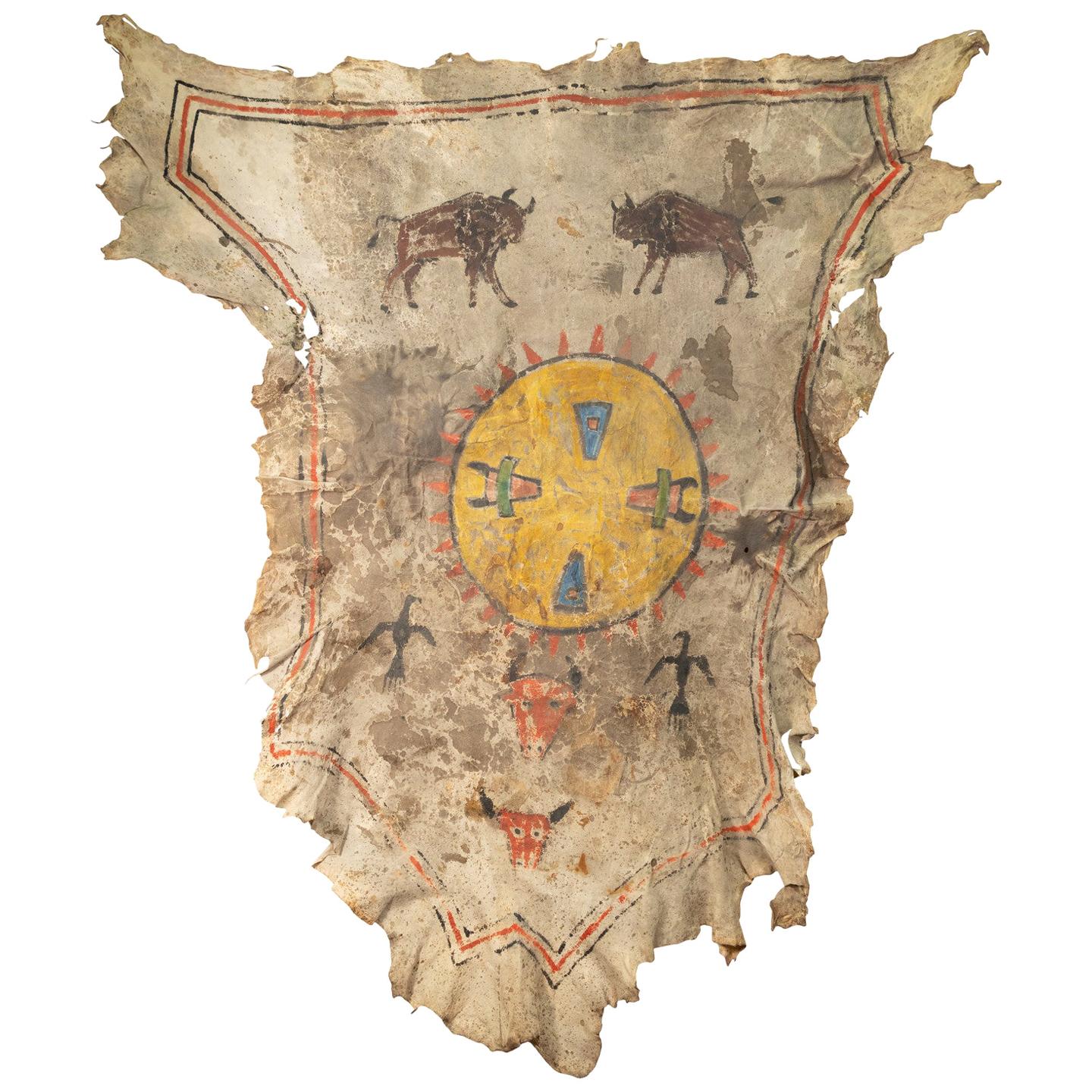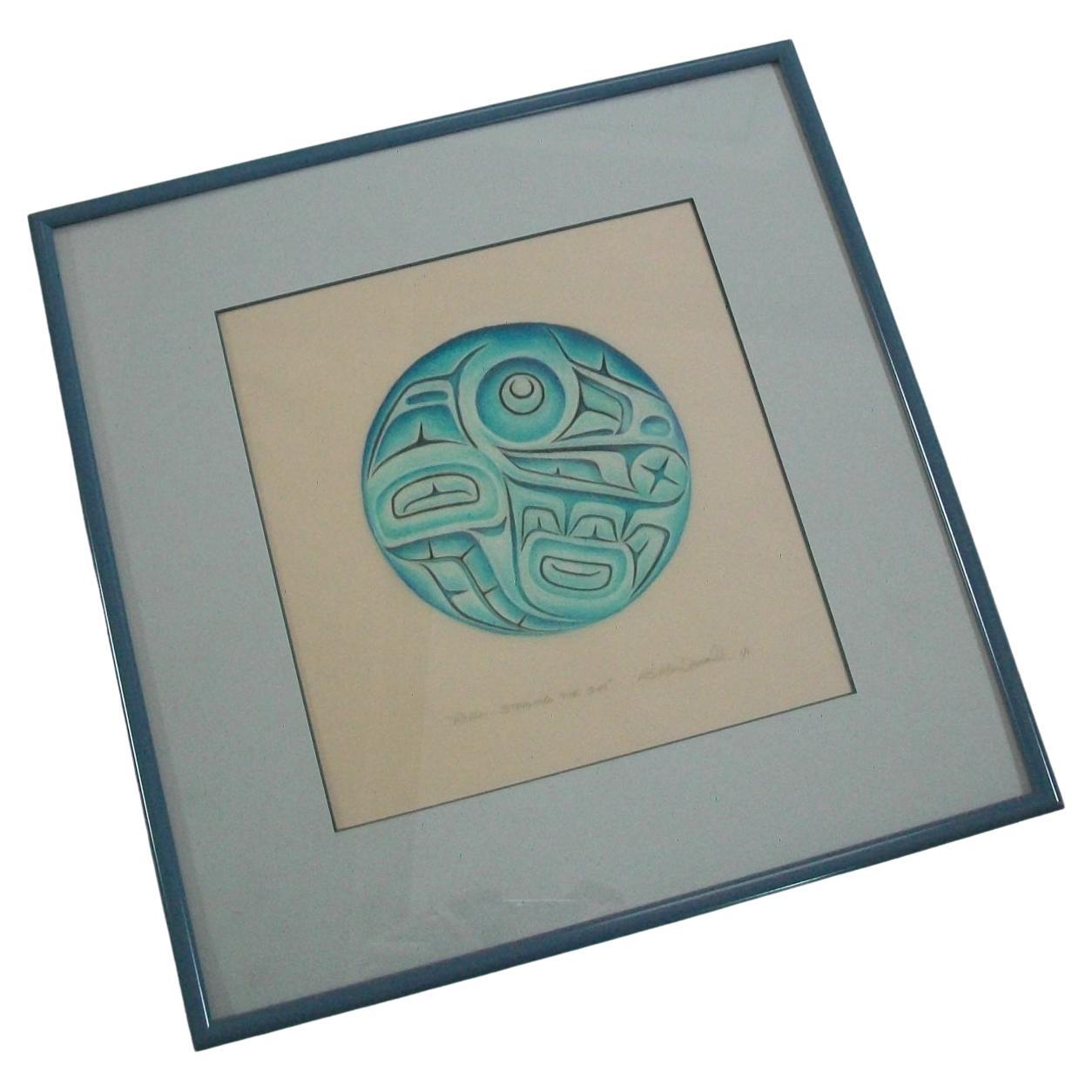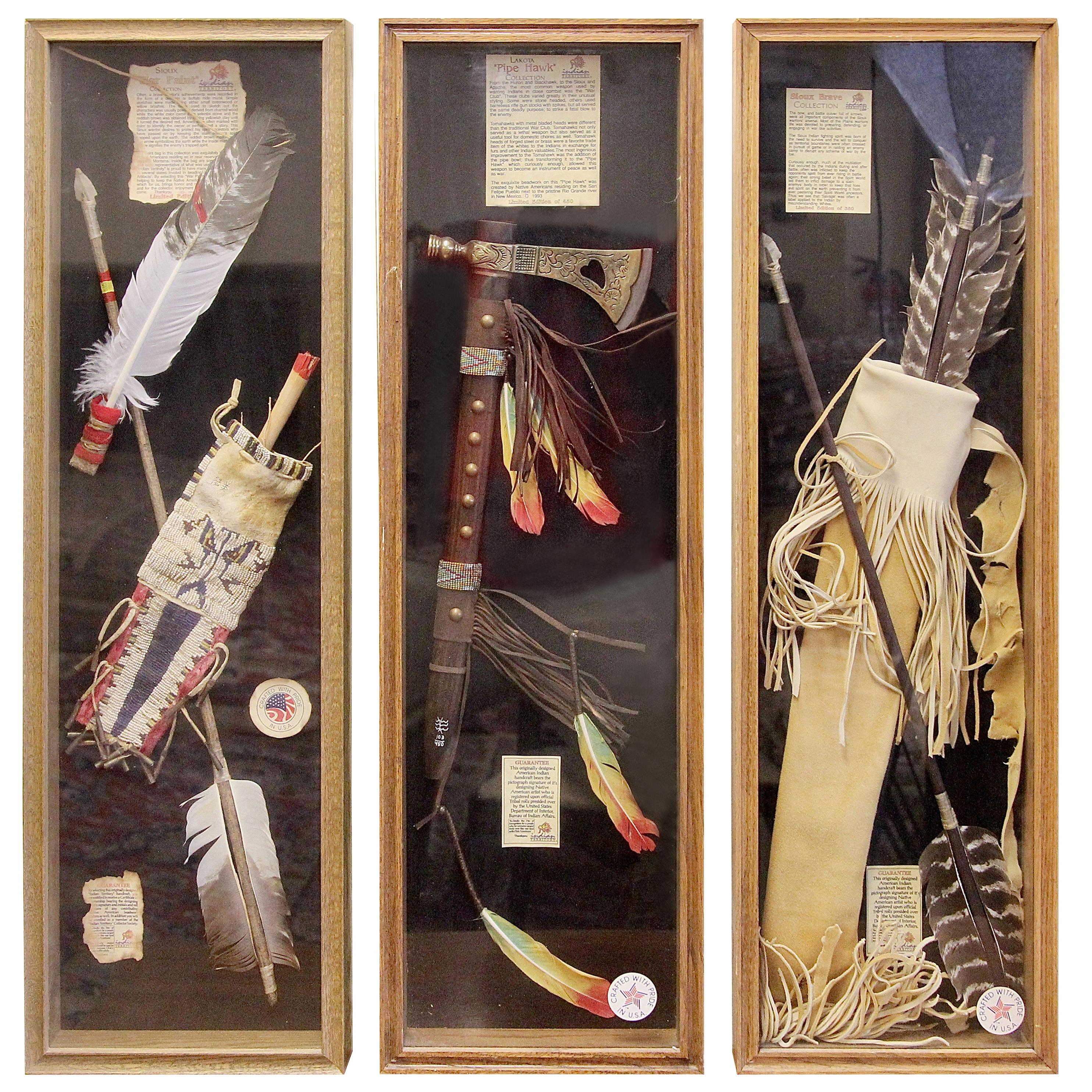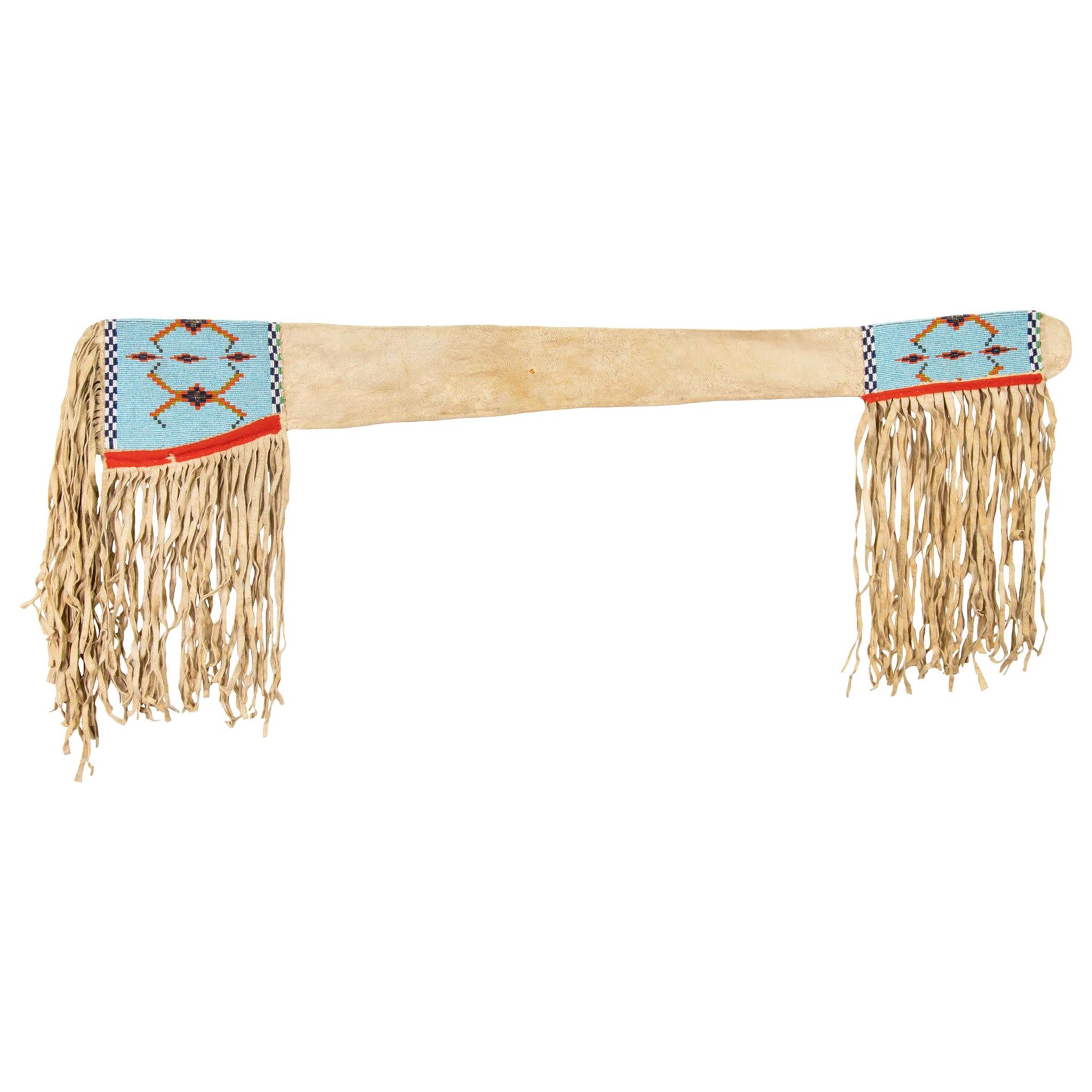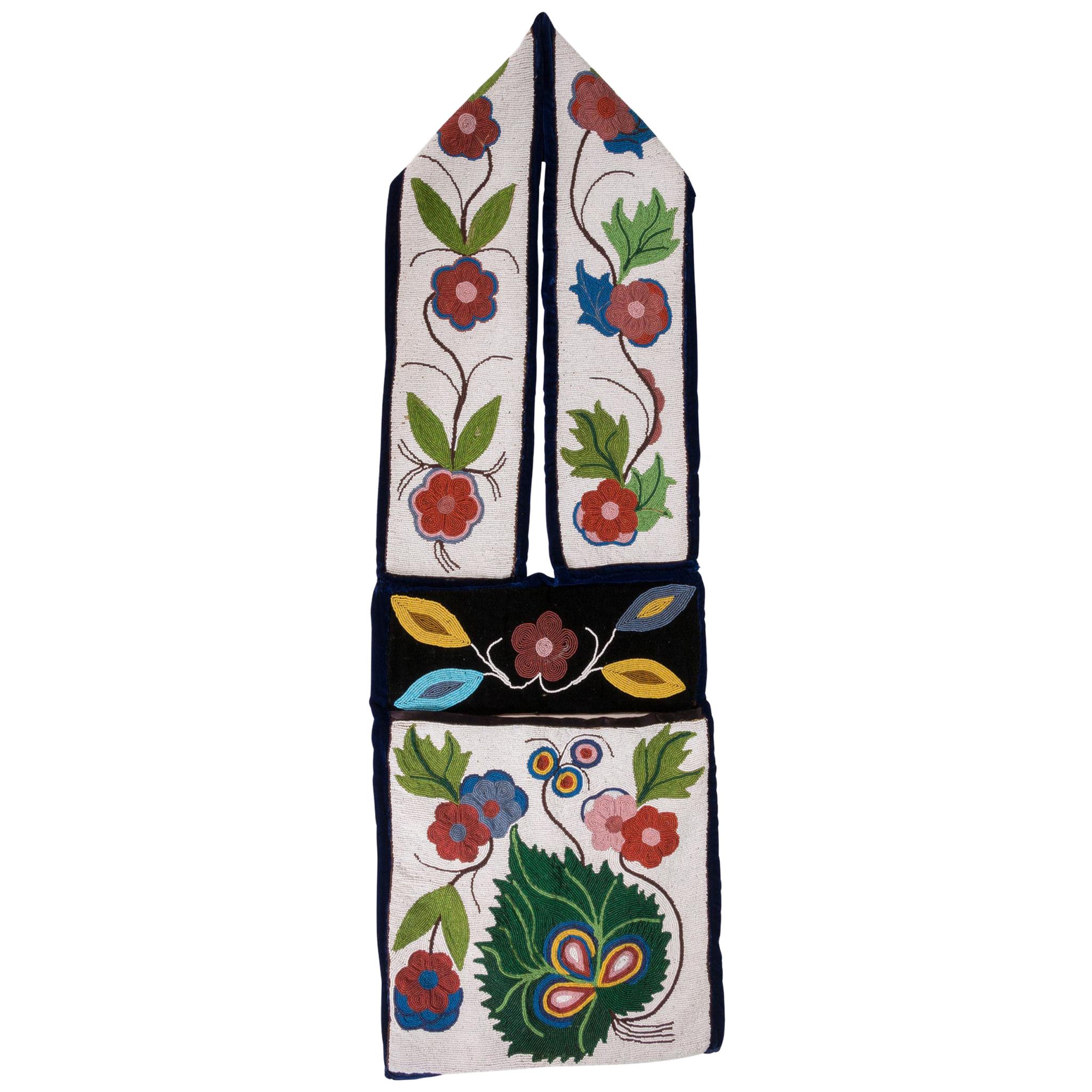Items Similar to Lakota Sioux Painted Buffalo Hide by Merle Locke
Want more images or videos?
Request additional images or videos from the seller
1 of 7
Lakota Sioux Painted Buffalo Hide by Merle Locke
About the Item
Lakota Sioux warrior painting on buffalo hide by Merle Locke. Paint on contemporary buffalo hide. Painting of 16 warriors riding on horseback, each carrying feathered coup sticks, surrounded by geometric motifs. Captioned "Lakota On Victory" and signed by the artist at lower right corner. Merle Locke is a member of the Oglala Lakota tribe, having grown up in the Porcupine district of the Pine Ridge Indian Reservation. He is known for his ledger art paintings, evoking the style's origins amongst the Plains tribes in the 1860s. By this time, buffalo had become increasingly scarce, and the older tradition of Plains hide painting migrated to ledger drawings out of sheer necessity. Merle's hide painting represents a full circle return to this traditional art, mirroring the return, if only partially, of the buffalo from the brink of extinction. Included are a selection of photographs of Locke with the robe, and a note from him to the purchaser, reading in part: "There are 16 horses on the hide painting. 16 is a sacred number among the Lakota, such as the 4 sacred directions, the 4 stages of life, the 4 sacred colors of mankind throughout the world, the 4 sacred animals. Each warrior is fully clothed with decorated regalia. The border along the buffalo hide represents the buffalo nation, protects the Lakota people."
Period: Early 21st Century
Origin: Lakota Sioux
Size: 60" x 56"
Family Owned & Operated
Cisco’s Gallery deals in the rare, exceptional, and one-of-a-kind pieces that define the history of America and the Old West. Our pieces range from American Indian to Cowboy Western and include original items of everyday life, commerce, art, and warfare that tamed America’s frontier. Our 14,000 square foot gallery opened in 1996 in beautiful Coeur d’Alene, Idaho.
Personal Service
Cisco’s operates on old fashioned values – honesty and integrity, and all of our items are backed by our money back guarantee. We appreciate the opportunity to earn your business. Whether you desire assistance with a jewelry purchase, choosing a gift, identification, or even selling – we hope to be your trusted source.
Northern Plains, Native American Paintings, Hides, Antiques, Vintage.
- Creator:Native Line (Maker)
- Dimensions:Height: 56 in (142.24 cm)Width: 60 in (152.4 cm)Depth: 0.5 in (1.27 cm)
- Style:Native American (Of the Period)
- Materials and Techniques:
- Place of Origin:
- Period:
- Date of Manufacture:1880
- Condition:Wear consistent with age and use.
- Seller Location:Coeur d'Alene, ID
- Reference Number:
About the Seller
5.0
Gold Seller
These expertly vetted sellers are highly rated and consistently exceed customer expectations.
Established in 1996
1stDibs seller since 2018
209 sales on 1stDibs
Typical response time: 2 hours
- ShippingRetrieving quote...Ships From: Coeur d'Alene, ID
- Return PolicyA return for this item may be initiated within 14 days of delivery.
More From This SellerView All
- 19th Century Northern Plains Hide PaintingLocated in Coeur d'Alene, IDNorthern Plains hide painting, buffalo society, pre-reservation. Two buffalo heads, two full body buffalos, two thunderbirds and buffalo sun shield in ...Category
Antique Late 19th Century American Native American Native American Objects
MaterialsOther
- Authentic 19th Century Lakota Sioux Child's BonnetBy Sioux Indian ArtLocated in Coeur d'Alene, IDAuthentic and genuine 19th Century Lakota Sioux fully beaded child's bonnet. Sinew sewn with cotton calico (flour sack) lining. Made for own use. Very few made, and fewer survived. B...Category
Antique Late 19th Century American Native American Native American Objects
MaterialsCotton, Beads
- Impressive 1870s Arapaho/Sioux Beaded Hide DressBy Arapaho Indian ArtLocated in Coeur d'Alene, IDFaceted Beads; Arapaho/Sioux dress on brain-tanned buffalo. Simple four color design; was probably the first dress made after quilling. Stars on dress, and...Category
Antique 1870s American Native American Native American Objects
MaterialsHide
- Sioux Child's MoccasinsLocated in Coeur d'Alene, IDSioux child's moccasins. 5 1/2" brain tanned elk. Classic Sioux buffalo hoof design with yellow crosses with red faceted beads and commercial tanned elk hide. Period: circa 1940. Or...Category
Vintage 1940s American Native American Native American Objects
MaterialsOther
- Sioux Catlinite Horse PipeLocated in Coeur d'Alene, IDSioux stylized catlinite horse pipe with saddle. Has been smoked. Neat collector piece. Origin: Sioux Size: 8" L x 3" H x 3/4" W. Family Owned & Operated Cisco’s Gallery deals in ...Category
Antique Late 19th Century American Native American Tobacco Accessories
MaterialsOther
- Native Sioux Quilled Council PipeLocated in Coeur d'Alene, ID19th Century Native American Sioux quilled and file-burnt stem with highly polished T bowl. Period: 19th century Origin: Sioux Size: 8" x 4 1/2", 36" ...Category
Antique 1870s Native American Tobacco Accessories
MaterialsOther
You May Also Like
- R. S. Macdonald, 'Raven Stealing the Sun', Framed Drawing, Canada, C.2001Located in Chatham, ONR. S. MACDONALD (Unknown/Unidentified Artist) - 'Raven Stealing the Sun' - Aboriginal colored pencil drawing on paper - original metal frame with single matte board and glass - title...Category
21st Century and Contemporary Canadian Native American Drawings
MaterialsMetal
- 10 x Native American Indian Territory Handcraft, Limited Edition, Sioux, NavajoLocated in Berlin, DE10 x originally designed American Indian Territory Handcraft, limited edition Collection of 10 important, detailed handcrafted Indian relics, artifacts. 1 x crazy horse, limited edition of 100, showcase 107cm x 35.5cm x 10.5cm 2 x Sioux war paint...Category
20th Century American Native American Native American Objects
MaterialsWood
- Pueblo Harvest Dance, vintage Painting by Jose Roybal (San Ildefonso Pueblo)By Jose RoybalLocated in Denver, COAn original watercolor painting by San Ildefonso (Pueblo) Native American artist, Jose Roybal (1922-1978) depicting the Pueblo Harvest Dance. Presented in ...Category
Vintage 1970s American Native American Paintings
MaterialsPaper
- Original Large Painting, Native American Ledger Drawing Style by Randy Lee WhiteLocated in Denver, COOriginal painting by Randy Lee White Native American Indian ledger style in acrylic on canvas with assemblage including feather and wood. Wrapped canva...Category
20th Century American Native American Paintings
MaterialsAcrylic
- 1870s Transitional Plateau Rawhide Parfleche Envelope with Geometric PatternsBy Plateau IndiansLocated in Denver, COA parfleche container in an envelope form, finely painted in an abstract design. Makes a stunning wall hanging alone or in a grouping with other parfleche or can be placed on a shelf or Stand. This was created by a North American Indian living in the Plateau cultural area - encompassing portions of what is now northern Idaho, western Montana, northeast and central Oregon, eastern Washington and southeast British Columbia. The tribes from this region include Kalispel, Flathead, Kutenai, Palus, Coeur D'Alene and Nez Perce. Parfleches are rawhide containers which were fundamental to the Plains way of life. Functioning essentially as protective travelling suitcases, they enabled the nomadic tribes to effectively pursue buffalo herds and migrate between seasonal camps. So critical were they to a nomadic existence that over 40 tribes are known to have historically produced parfleches. Collectively, these tribes inhabited an area which encompassed the entirety of the Plains, as well as the parts of the Southwest, the Transmontane and Western Plateau regions. Parfleches were, out of necessity, robust and versatile objects. They were designed to carry and protect within them anything from medicinal bundles to seasonal clothing or food. In fact, it was because of the containers’ robusticity and variety that parfleches earned their name in the Anglo world. Derived from parer (to parry or turn aside) and fleche (arrow), the word parfleche was coined by 17th century French Canadian voyageurs and used to describe indigenous objects made from rawhide. Despite their common utilitarian function, parfleches served as one of the major mediums through which Plains Indian tribes could develop their long-standing tradition of painting. In fact, it is in large part due to the parfleche that tribal style emerged. Even though parfleche painting developed simultaneously with beading and weaving, painting as an artistic tradition held particular importance in tribal culture. Believed to have evolved from tattooing, it had always been used as a conduit through which tribal and individual identity could be expressed. As such, many tribeswomen were deeply committed, some even religiously, to decorating their parfleche either with incised or painted motifs that were significant to them and/or the tribe. For some tribes, such as the Cheyenne, the decorative processes which surrounded parfleche production were sacred. For others, it seems that their parfleche designs shared an interesting artistic dialogue with their beadwork, indicating a more casual exchange of design motifs. This particular relationship can be seen in Crow parfleche...Category
Antique Late 19th Century North American Native American Native American...
MaterialsHide
- Pair of Signed Patrick Amos West Coast Nootka Haida Framed PrintsLocated in Hamilton, OntarioThis pair of framed prints were done by the well known Indigenous artist Patrick Amos of Nootka, British Columbia Canada in his signature West Coast Haida style. Each of the prints i...Category
Mid-20th Century Canadian Native American Native American Objects
MaterialsPaper
Recently Viewed
View AllMore Ways To Browse
American Traditional Furniture
American 19th Century Antiques
Early American Style Furniture Furniture
Contemporary American Jewelry
Antique American Painted Furniture
American Antique Jewelry
Early American Period Furniture
Early American Jewelry
Vintage Native
19th Century Painted American Furniture
Early American Folk Art
19th Century American Jewellery
Antique Native American Furniture
Antique Native Indian
Old Native American Jewelry
Antique Native American Indian
Antique American Indian Jewelry
Antique American Pine Furniture
